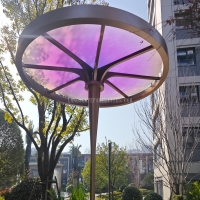Welcome to the website for landscape facilities products and knowledge.
How do manufacturers test the resistance of landscape round trash cans to heavy snowfall?
Manufacturers rigorously test the resistance of landscape round trash cans to heavy snowfall to ensure they withstand harsh winter conditions. These tests simulate real-world scenarios to evaluate durability, structural integrity, and performance under snow load.
One common method is static load testing, where weights equivalent to heavy snow accumulation are placed on the trash can lid and body. Engineers measure deformation, material stress, and whether the bin remains functional after the load is removed.
Another approach involves environmental chamber testing, where trash cans are subjected to freezing temperatures and simulated snowfall. This helps assess how materials like polyethylene or metal react to prolonged cold exposure and moisture.
Field testing is also critical. Manufacturers place prototypes in high-snowfall regions to observe real-time performance over an entire winter season. Factors like lid sealing, hinge strength, and base stability are closely monitored.
Advanced manufacturers may use computer simulations (FEA analysis) to predict how different snow loads impact the trash can’s design before physical testing begins. This optimizes materials and structural support.
By combining these methods, manufacturers ensure landscape trash cans resist heavy snowfall, preventing cracks, collapses, or operational failures—key for parks, streets, and public spaces in snowy climates.
Related search:

Recommendation
Metal frame with gradient color acrylic combined with high-end shading landscape facilities